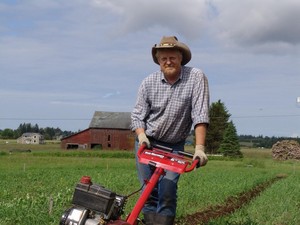06 Jul Mon 2009
Buckwheat
Yesterday I sowed a small plot of Japanese buckwheat. Buckwheat is a very good summer cover crop. It comes up fast, grows fast, suppresses weeds and is easy to till in. Recommended seeding rate is 2-3# per 1000 square feet. Last year I got some from Organic Growers Supply (a Fedco division), but Osborne in Mount Vernon, WA also has a different variety (look in the cover crops section of their catalog or look it up online). I let it grow to maturity last year and harvested the seed by shucking it off into a bucket. 5 gallons took less than an hour. The grain was quite clean but it was easy to get out the occasional stem by rubbing the grain between my hands and winnowing in the wind. After I sowed this year's crop from my own seed, I got out my Corona hand grinder, set it on coarse grind and ground up the hulls and all into flour (because of the polygonal shape, it may be more difficult to hull than wheat). It was then easy to sift out the chaff with a kitchen strainer. The yield was 40% flour and 60% chaff. Then I took some of the flour and mixed it half and half with whole wheat flour and had pancakes. Delicious. I also boiled up the hulls and made a thick soup broth, which I can use for soup, a thickening agent, or as the liquid in my pancake mix.
Buckwheat can be a very important grain for the home gardener. It is easy to grow, provides good bee forage as well as outstanding honey, can be stored easily until needed and has proven to be a good alternative for people with celiac disease. Buckwheat does have oxalic acid in it and is in the same taxonomic family as rhubarb (Polygonaceae), so a person should experiment with small quantities of it, if you don't eat it already.
My next small-scale grain crop will be barley, then oats, winter wheat and spelt. The barley is a 2-row awnless spring barley that came up fast and smothered all weeds. It is turning yellow now and looks quite attractive in the sunlight. Since I have always been intrigued by the transition from hunting/gathering to grain production, I am going to try out one of my pet theories - early grain production stimulated by a fondness for fermented beverages. I plan on harvesting by hand, and sprouting the grain with whatever stems are left using my primitive hand techniques. Then I will lightly toast the result in my largest cast-iron pan and boil my wort stems and all. I plan on making both an unhopped and a hopped ale, using my own hops, so the beer will be an all-farm product, except for the yeast. I might even make a batch using wild yeast. We shall see.
The point to all this is to demonstrate small-scale grain production at the home gardener level. For further information you can check out Gene Logsdon's Small Scale Grain Raising, 2nd Edition (2009). Buckwheat is the perfect summer cover crop and you can get 2-3 crops in a year, depending on the length of the growing season. It is easily killed by frost and you can just bend it over with a rake and till it in.
Buckwheat can be a very important grain for the home gardener. It is easy to grow, provides good bee forage as well as outstanding honey, can be stored easily until needed and has proven to be a good alternative for people with celiac disease. Buckwheat does have oxalic acid in it and is in the same taxonomic family as rhubarb (Polygonaceae), so a person should experiment with small quantities of it, if you don't eat it already.
My next small-scale grain crop will be barley, then oats, winter wheat and spelt. The barley is a 2-row awnless spring barley that came up fast and smothered all weeds. It is turning yellow now and looks quite attractive in the sunlight. Since I have always been intrigued by the transition from hunting/gathering to grain production, I am going to try out one of my pet theories - early grain production stimulated by a fondness for fermented beverages. I plan on harvesting by hand, and sprouting the grain with whatever stems are left using my primitive hand techniques. Then I will lightly toast the result in my largest cast-iron pan and boil my wort stems and all. I plan on making both an unhopped and a hopped ale, using my own hops, so the beer will be an all-farm product, except for the yeast. I might even make a batch using wild yeast. We shall see.
The point to all this is to demonstrate small-scale grain production at the home gardener level. For further information you can check out Gene Logsdon's Small Scale Grain Raising, 2nd Edition (2009). Buckwheat is the perfect summer cover crop and you can get 2-3 crops in a year, depending on the length of the growing season. It is easily killed by frost and you can just bend it over with a rake and till it in.
Walter_1
09:49 AM PDT


Hi Walter,
I dropped by on the 3rd to buy some potatos and we got to chatting. first of all the red fingerlings were excellent and my potato salad got rave reviews. Thanks for the great, nutritious produce. I told my friends about FA Farms and your location. so hopefully you'll find a few more customers.
I totally support your foresight and efforts to grow better than the FDA-definition of organic. Let's stay in touch and I'll continue to sing your praises.
Tom O'Connor
253.227.2505 cell
streamdude@yahoo.com email